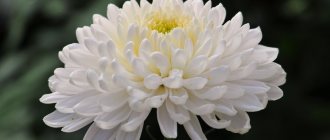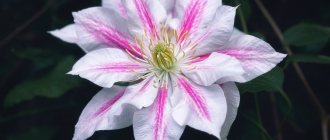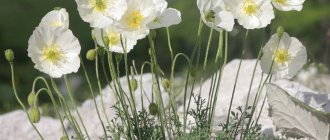Among the variety of garden perennial plants, multiflora chrysanthemums occupy a special place. And the point is not only in the variety of its varieties and colors, but also in the long and late flowering period, thanks to which these magnificent flowers decorate household plots, depending on the characteristics of the variety, from early August to late autumn.
What is chrysanthemum multiflora globular
Multiflora or Chinese spherical chrysanthemum is a representative of the Asteraceae family, a variety of garden bush chrysanthemums with numerous small flowers. Breeders bred this fairly young and very decorative variety not for cutting, but for decorating the garden. When the multiflora fully blooms, it looks like a picturesque flower ball, through which almost no foliage can be seen. Low spherical bushes look ideal in borders, hills, ridges and flower beds. It is noteworthy that the spherical shape of the bush is natural, forms independently and does not require special actions on the part of the gardener to maintain the outline.
In addition to the special shape of the bush, multiflora also differs from other chrysanthemums in its flowering time. Its petals bloom very early, long before the onset of frost, most often in September, and early varieties bloom already in mid-August. Despite the fact that such varieties began to be actively developed relatively recently, today there are already several thousand hybrids that differ in the shape and color of the inflorescences.
The height of multiflora bushes on average rarely exceeds 40 cm; thanks to this property, it received another name - low-growing, spherical chrysanthemum. However, among the representatives of the family there are many taller specimens.
According to the height of the bush, varieties are distinguished among the varieties of multiflora
:
- low-growing border chrysanthemums - 20-30 cm;
- medium height - 30-50 cm;
- tall - 50-60 cm.
Thus, for any flowering component of landscape design there is a plant suitable in height.
The multiflora also differs in the timing of the beginning of flowering
:
- early varieties - August;
- average - September;
- late - end of September, beginning of October.
By combining several varieties of multiflora in your garden plot, you can enjoy its abundant flowering from late summer until frost.
An important advantage of the variety is that there is no need to prune plants, since the spherical shape of the bush is genetically inherent in them. To make it more perfect, it is recommended to pinch the chrysanthemum (the top of the flower) when 2-4 pairs of leaves have already bloomed on it. But this is not at all necessary, and without additional pinching, the multiflora has a beautiful round shape.
The only significant drawback of such chrysanthemums is that most of their varieties are not winter hardy. In frosty winters with little snow, they freeze out even with shelter. You cannot leave them in the open ground for the winter.
What is the difference between Korean chrysanthemum and multiflora? Chrysanthemum (globular): types and description
Multiflora belongs to the Korean group of chrysanthemums. It was bred as a low-growing border species not intended for cutting. The plant is thermophilic - it does not overwinter in open soil, except in the south, and often freezes even when covered for the winter. At the same time, spherical chrysanthemums are not strictly street flowers; they feel good in pots - on balconies, loggias, verandas and even in ordinary apartments.
The “highlight” of Multiflora is that the eye-catching ideal round shape is not the result of the formation of the bush, but a genetically inherent feature. The upper floral layer of this ball is so dense that in some varieties of chrysanthemum the spherical foliage is completely invisible. There are, however, recommendations for pinching the flower tip in the phase of 2-4 leaves, but this condition cannot be called mandatory. Multiflora will be round and plump without this.
But without what the spherical chrysanthemum will not be able to meet your expectations - without a completely open, sunny place. The plant does not even like partial shade or proximity to trees. Any depressing factor will negatively affect the formation of the coveted ball.
Classification of globular chrysanthemums by flowering time:
- early - bloom in August
- medium - bloom in September
- late - bloom in October or late September
Depending on the height of the bush, spherical chrysanthemums are:
- short (from 20 to 30 cm)
- medium height (from 30 to 40 cm)
- tall (up to 70 cm).
Preparing multiflora chrysanthemum for wintering
Before growing spherical chrysanthemums, you need to understand: most varieties of chrysanthemums are not afraid of frost, they can be safely left to overwinter in open ground, but not multiflora. Like any artificially bred hybrid, it has lost some properties characteristic of its species. It is capable of surviving the winter under cover in the open ground only in the southern regions. In other regions, to make flowers pleasing to the eye longer, from the first weeks of October they are covered with polyethylene at night and dug up after flowering.
It is advisable to dig up the multiflora before the first frost arrives, usually at the beginning, middle or end of October, depending on the latitude of the region. For wintering in the Moscow region and central Russia, the stems are cut off and the roots are placed in boxes with soil, which are kept in a dark room at a temperature ranging from -5 to +3 °C. The soil in the boxes should be moderately moist, not too damp or dry. To ensure that buds form on the branches by the time they are planted in the ground, they are already exposed to the sun in April.
Before wintering, make sure that the chrysanthemum does not suffer from diseases or pests. It is important. If the plant is sick with something, it most likely will not be able to survive the winter. Try to recognize problems and fix them while it's still warm outside.
In the same way, wintering is provided for multiflora, which is grown and cared for in pots. The air in apartments in winter is too warm and dry for it, so in the fall, potted multiflora is also trimmed and stored in a dark, cool place.
It is also necessary to ensure that the plants being preserved have a sufficient amount of minerals and nutrients in the winter. To do this, fertilizing is applied to the soil from the beginning of September. Phosphorus-potassium fertilizers are best suited; they not only promote abundant flowering, but also contain all the substances the flower needs for a successful winter.
The basement or cellar where you store plants during the winter should be free of fungus and mold. To avoid their occurrence, you should establish a high-quality ventilation system. If there are traces of fungus on the walls or floor, it must be scraped off and the area treated with a solution of copper sulfate or used machine oil.
Video: multiflora chrysanthemum preparation for winter
Care Tips
In order for the chrysanthemum to delight with its beautiful blooms, it is necessary to carefully care for it correctly:
- Chrysanthemums need to be watered regularly with rainwater. If there is no rain for a long time, you can use settled water. Water frequently, but do not over-moisten the soil. Such watering will help preserve the decorative appearance of the bush for as long as possible. If the earthen ball dries out, this will lead to lignification of the shoots. If the soil remains dry for too long, the plant may die. Multiflora chrysanthemums are not sprayed.
- Fertilizing can be done once a season, soon after planting, with nitrogen fertilizers. You can use an infusion of mullein or chicken droppings. Some gardeners add potassium and phosphorus. But this must be done before the buds form.
- After flowering, cut the stems at a distance of 10 cm from the ground. This will stimulate the growth of young shoots. The plant will be more resistant to diseases.
- The disadvantage of multiflora chrysanthemums is their lack of frost resistance. Which, however, is typical for most chrysanthemums. Therefore, it is better to plant them in flowerpots or containers for the winter. They are brought into a cool room - a veranda, a glazed balcony. This will extend the flowering period. Chrysanthemums will delight the eye even in winter, until approximately January. In a warm room they dry out quite quickly, losing their decorative effect.
- After the chrysanthemum has bloomed, cut off the stems and take the pots out for winter storage. Periodically inspect to see if the lump of earth in the pot has dried out.
For the southern regions, a scheme for growing chrysanthemums without digging is suitable. Simply cut the stems and cover the bushes with humus or soil. Sometimes it is covered with a cut part of the plant. But this cannot be done if the plant is sick or damaged by pests. In spring the cover is removed. This must be done on time, during the snow melting period, otherwise the roots may rot. The bush must be planted into several, one or several sprouts.
Globular chrysanthemum: planting and care
Growing spherical chrysanthemums, like any other, requires compliance with certain rules. A well-chosen place is one of them. Multiflora is photophilous and is planted in sunny areas. If there is insufficient lighting, the shoots will stretch to the side where there is more light, and the shape of the bush will be distorted. In addition, the lack of light will negatively affect the timing and duration of flowering.
Multiflora should not be planted near fences and walls. Due to the fact that the fence disrupts adequate lighting, the plant is not able to form a bush of the correct spherical shape.
The second condition for growing a beautiful and healthy plant is suitable soil. The area for multiflora is prepared in advance. In the fall, humus and ash are added to the soil and dug up properly. In the spring, before planting the plants, the area is dug up again.
Chrysanthemum is a moisture-loving plant that needs moisture-permeable, light and nutritious soil. The optimal composition is peat mixed in equal quantities with sand and peat turf soil. This mixture is used to fill the hole in which the chrysanthemum is planned to be planted. Pure peat dries out too quickly and is therefore not suitable.
There are several ways to propagate the multiflora chrysanthemum.
:
- seeds (direct sowing and sowing of seedlings);
- shoots (dividing the uterine bush);
- cuttings.
Planting by seeds
Direct sowing of seeds is carried out at the end of April, beginning of May. The procedure is as follows:
- Prepare holes 18-20 cm deep at a distance of 25 cm.
- The holes are watered abundantly.
- Place 3-5 seeds in each hole.
- The holes are sprinkled and covered with polyethylene so that seedlings appear faster.
Planting by sowing seedlings involves growing chrysanthemum sprouts at home and then planting them in open ground. You can start already in the last days of February. The procedure is as follows:
- The soil is poured into a pre-prepared container and moistened with a spray bottle.
- The seeds are scattered on top of the soil.
- The container is covered with plastic film. The air temperature in the room should be between 23-28 °C.
- The soil is periodically moistened, preventing it from drying out; the film is raised daily for 25-30 minutes for ventilation.
- When the first leaves appear, a pick is made (the plants are transplanted into a large container).
When the stems get stronger and reach a height of about 20 cm, the seedlings are transplanted into a flower garden.
Dividing the bush
Growing multiflora from seeds is quite difficult. Most often it is propagated by cuttings and dividing queen cells and cuttings. Seedlings or cuttings can also be purchased in the store. It should be borne in mind that good specimens should have at least 5 leaves.
In an overwintered multiflora chrysanthemum, young shoots grow from the rhizome. They can simply be separated from the rhizome and planted for rooting in an individual pot (one shoot at a time).
Reproduction of multiflora by division is preferable to planting by seeds, since it allows you to preserve the species characteristics of the variety, but loses in comparison with cuttings, since it is not always possible to grow a multiflora chrysanthemum by division in the shape of a regular ball, especially in the first year. In addition, cuttings make it possible to obtain many more new plants from one bush per season.
By dividing an overgrown uterine bush, you can get several new ones from one adult flower. To do this, you need to dig up the chrysanthemum, divide its root system into several parts and cut or pinch the shoots. Organic fertilizer is added to the holes before planting the cuttings, and then the holes are watered abundantly.
Cuttings of multiflora chrysanthemum in spring
It is not advisable to grow one chrysanthemum bush for more than two years in a row - there are fewer flowers, and the bush itself disintegrates. Therefore, at the end of the second season, the bush should be divided into cuttings and planted. Then the flowerbed will delight you with its beauty for many years to come.
There are several ways to propagate chrysanthemums. Cuttings are the most popular, effective and easiest of them. The cuttings fully retain all the specific properties of the mother flower: color, size, correct spherical shape of the bush. To get a healthy varietal plant, which can also be propagated later, even one cutting is enough. With the right approach, by the end of summer it will grow into a spherical bush completely covered with buds.
Before cutting chrysanthemums, you need to prepare a container for seedlings. First, its bottom is covered with sand. Multiflora is an unpretentious plant, so it is not necessary to calcinate the sand. Then prepare the soil: mix a bucket of soil, a bucket of peat and half a bucket of sand. The resulting mixture is poured into a container on top of sand in a layer approximately 12 cm deep, and mulched on top with sand, but already calcined. This container is convenient when you plan to root a large number of cuttings.
If the seedlings are a little more convenient, it is more convenient to plant them in separate cups filled with light and loose substrate or peat or coconut tablets. Cuttings in tablets root especially well.
Cuttings are taken from the mother bush in early March. The optimal cutting size is 10 cm. The lower leaves are removed. Prepared cuttings should be kept in Kornevin's solution for about a day or the sections should be dipped in Clonex Gel and then stuck into a prepared box with soil. The survival rate of multiflora cuttings is high, they grow quickly, so there is no need to plant them close to each other. The optimal distance between them is 9-10 cm.
The planted cuttings are kept in a greenhouse or simply a warm room with high humidity for 12-15 days. They are sprayed 2-3 times a day with some rooting stimulant, for example Energen or Epin. During this time, they will take root and be ready to be transplanted into separate containers or open ground. In order for the plants to form the correct spherical shape, seedlings are pinched from 7-8 leaves.
Video: propagation of multiflora by cuttings
When and how to carry out cuttings
One method of cuttings involves the advance preparation of a mother bush, from which planting material can be obtained in the spring. Varieties with large buds produce from 8 to 15 cuttings, and small-flowered chrysanthemum bushes produce 20 or 30. The second option is to repeatedly prune non-lignified stems from late spring to early autumn.
Preparation and storage of the mother bush
In late autumn (before the onset of stable frosts), cut off all the stems of the selected mother bush, leaving stumps of about 5 cm. 10–15 days after cutting, dig up the bush and, together with a lump of earth, place it in a container of suitable size. Cover exposed roots, as well as possible voids, with soil or sand. Move the container to a dark, cool room.
Attention!
Make holes in advance at the bottom of the container for the mother liquor and lay a layer of drainage from 2 to 5 cm; you can use vermiculite, broken stone or expanded clay.
If you transfer the queen cell to a greenhouse or any other warm room, the first stems will appear within a couple of weeks. If you want to preserve the queen cell until spring, move it to a basement or cellar; in a city apartment, any dark place where the temperature does not rise above +7 degrees will do. If the temperature regime is not observed, the buds will hatch ahead of schedule.
If the chrysanthemum bush is stored in a damp basement, there is no need for frequent watering. Moderate moisture is permissible only when the soil dries out; overwatering will lead to rotting of the roots. To start cuttings in March, the mother plant is transferred to a warm place in mid-February, watered abundantly, young shoots will hatch in 5–10 days. How to cut and root cuttings:
- when the shoots grow 8–10 cm, cut them so that stumps with two pairs of leaves remain on the mother plant. This will provide the basis for the appearance of new stems;
- It is better to leave small cuttings on the bush, they are prone to rotting, choose the strongest specimens;
- 2 lower leaves of the cut stems are cut off (the buds are left);
- cuttings one by one, in pairs or in groups of 3 are planted in separate containers with moist soil to a depth of 1.5 to 1.8 cm;
- in the case when a wide container is chosen for planting, the cuttings are placed at a distance of 5 cm from each other.
You may be interested in:
Perennial flowers for a flower bed, blooming all summer: low-growing Along with annual flowers in a flower bed, summer residents always try to plant perennial flowers, and sometimes only...Read more...
If desired, the tip of the shoots can be dipped in Kornevin, however, the practice of those who have been propagating chrysanthemums for a long time shows that they take root well without additional stimulation. When cutting in autumn, the shoots should not be cut off from the mother plant, but carefully separated along with the roots; this procedure will guarantee 100% survival of the cuttings.
To prevent the cuttings from drying out, it is necessary to create greenhouse conditions for them. Cover small pots with transparent plastic cups, cover large containers with polyethylene so that the leaves and stems do not touch the covering material. The rooting process can take from 2 to 3 weeks; the buds wake up within 3–4 days after planting the cuttings.
Cuttings of flowering chrysanthemums
The procedure can be carried out throughout the growing season; the process is very similar to growing roses, hydrangeas and other garden flowers. The simplest option is to cut off any branch and bury it in the garden, but such experiments do not always end successfully. We suggest that you familiarize yourself with step-by-step instructions for propagating chrysanthemums by cutting flowering shoots in the fall:
- cut the stems into cuttings 11–16 cm in length, leaving those that were closer to the root;
- cut off the bottom 2 leaves;
- place the resulting stems in a jar or glass made of transparent glass, pour in settled water (fill no more than 3 cm of the container);
- add to the water a small amount of a drug that stimulates root formation - Kornevin, Ribav E, Heteroaxin, Kornerost or any other;
- Place the cuttings on the windowsill, slightly shaded from direct sunlight.
Attention!
During the process of rooting the stems, water must be added as it evaporates; there is no need to completely change the liquid.
The cuttings will take root in 30–40 days, and young shoots will begin to grow. It is undesirable to leave them in water; some of the planting material may die before spring, and only a few stems will acquire powerful roots. It is better to transplant the cuttings into a separate container with soil. Using shoots that are too thin or an opaque container will result in the rooting process taking much longer.
Cover the transplanted cuttings with plastic cups or plastic bags and periodically moisten the soil. You can remove a kind of greenhouse when the stems are completely rooted in the ground and begin to grow. As soon as the temperature outside is above +5 degrees, you can begin to harden the seedlings, take them out to the balcony or open the window for 15 minutes at first, gradually increase the time.
How and at what time to plant multiflora chrysanthemum in open ground?
Chrysanthemum bushes are planted in open ground in the middle zone in the first days of May, in the south in early April. In the northern regions, it is more convenient to plant these flowers not in open ground, but in spacious pots, so it will be more convenient to put them away for storage in the basement in winter. In Siberia, multiflora chrysanthemums in Siberia need to be taken outside from the basement in mid-May.
To grow high-quality plants, it is necessary to leave a large gap between the bushes so that they can acquire the rounded outlines typical of Multiflora. In thickened, fused plantings, the beauty of chrysanthemums will not be visible.
Bushes or seedlings are planted at a distance of no less than 40-50 cm for low-growing and dwarf varieties and 60-70 cm for other varieties.
Before planting, the holes, as already mentioned, need to be filled with soil mixed with complex fertilizer, and 3 liters of water are poured into them. If, when digging up overwintered rhizomes, damage is discovered, they need to be treated with special preparations, for example, Fitospay. The plant must be planted carefully, trying not to damage the roots and not allowing them to tuck, going deep into the soil until the first leaves. Normally, after 2-3 weeks these leaves will die off. In the first week after planting, the multiflora needs high humidity; to maintain it, the bush is covered with a plastic or glass cap.
Chrysanthemum multiflora: care
Proper watering plays a leading role in how to care for spherical garden chrysanthemums. They are watered not often, but abundantly. Abundant irrigation stimulates root growth deep into the soil, making the plant easily tolerate periods of dryness. Each time after watering, the soil is loosened. Gardeners who do not have the opportunity to frequently visit their plot, water and loosen it, it is advisable to mulch the ground with sawdust, straw or pine needles.
It is not recommended to grow chrysanthemums in one place for more than 2 years, so the plant is replanted every 3 years.
Caring for spherical chrysanthemums also includes mandatory feeding with organic matter when the first buds appear. A solution of fresh cow dung - mullein - is suitable for this purpose. It contains all the micronutrients necessary for multiflora and is absolutely safe for the soil.
It's easy to prepare mullein:
- In a large bucket, mix 5 parts water with 1 part manure and cover with a tight lid.
- The resulting solution is infused for 2 weeks, remembering to stir it daily and close it tightly again.
- In two weeks, the mixture will ferment and become lighter in color, and undissolved manure particles will sink to the bottom.
Before watering, the finished mullein should be diluted with water in a ratio of 1:10. To improve nutritional value, you can add wood ash and superphosphate to it - 500 g of ash and 100 g of superphosphate per 10 liters of mullein diluted with water.
As already mentioned, there is no need to pruning or trimming the multiflora. But if it is not possible to plant the cutting in open ground immediately after rooting, it will stretch out and outgrow it. In this case, pinching the overgrown shoot once will facilitate the easy and rapid formation of a spherical bush.
To prevent fungus in rainy summer and autumn, when there are significant differences in night and day temperatures, multiflora is treated with preparations containing copper, such as Bordeaux mixture, Oxychom, Hom and the like.
Rules for caring for plantings
Domestic multiflora requires the formation of a crown. It is enough to pinch young shoots twice in the spring. This will give abundant growth of new shoots and maintain the correct shape of the bush.
Care also requires replanting young potted plants annually, and adult ones every 2 years. When transplanting, the substrate changes, the pots should be larger.
Adult chrysanthemums grown in beds are rejuvenated every 2-3 years in the spring by dividing and transplanting to a new location.
To enrich the root system with oxygen and water permeability, it is necessary to loosen the soil and remove weeds. It is advisable to loosen after each watering.
In addition to the listed activities, crop care includes watering, fertilizing, and combating diseases and insect pests.
Features of watering
To prevent rotting, the roots of an overwintered plant should not be watered abundantly. The mother bushes are irrigated only after drying, gradually increasing the amount of water.
Watering the plant is carried out with rain or settled warm water.
Water more often in summer, especially during hot weather. Moderate watering helps maintain shape, lush flowering, and prevents excess moisture and root rotting.
Insufficient soil moisture can cause lignification, and drying out of the soil can lead to the death of the crop.
To avoid sunburn, water in the morning or evening, avoiding getting water on the leaves and flowers.
Loosening the soil affects not only the enrichment of the roots with oxygen, but also the permeability of water.
Chrysanthemums grown at home are watered more often 2-3 times a week. Watering through a tray is not recommended. The optimal soil condition is moderately moist.
How to fertilize chrysanthemum
When planting, you need to avoid mineral fertilizers. To take root, culture needs rest. The first feeding is carried out after two weeks. It includes a complex of minerals: nitrogen, potassium, phosphorus.
Nitrogen is necessary for the growing season of chrysanthemums until buds form.
The second feeding is carried out before flowering. Having eliminated nitrogen, magnesium is added to the mineral mixture.
Spraying with potassium humate will make the color of the flowers more saturated. Banana peels can be used as a source of magnesium. It is dried, made into powder, tincture, decoction, or buried in the soil.
For better wintering, fertilizing with superphosphate is done for the third time in October.
If there is a lack of minerals, the shoots do not form the desired shape. Not enough buds are formed, they will be small and sparse, and the duration of flowering will decrease.
Excess fertilizer also negatively affects the crop. High nitrogen content stimulates the growth of diseases and insect pests.
How to care for a plant after flowering
At the end of flowering, you need to wait until the inflorescences completely wither and the crown loses its shape. Only after the growth points have formed can pruning be done. The plant is watered abundantly and sent for the winter.
If the crop is grown at home, after flowering, do minimal pruning and water regularly. Left in the same place, the chrysanthemum remains dormant for a short time. Then the vegetation cycle and care are repeated.
It is not recommended to grow a crop in one place for more than two years without rest. At the end of flowering in the second year, it needs to be pruned and put away for the winter. During the dormant period, watering is not required.
Chrysanthemum multiflora in Siberia: planting and care
The only drawback of this magnificent plant is insufficient winter hardiness, so multiflora chrysanthemum is very rare for Siberia. The maximum subzero temperature it can withstand is 6-7 °C. In regions with harsh winters, its bushes often die even under good cover.
The way out is to cultivate winter-hardy varieties adapted to the northern climate. Experts work a lot in this direction, breeding unpretentious early varieties of multiflora chrysanthemums, the buds of which form already in mid-July, bloom from early August to mid-September and have time to bloom before frost.
Multiflora must be prepared with special care for wintering in Siberia. It must be transferred to the shelter from the end of September and stored as described above. The room where the flower will winter should be free of dampness, mold, mildew, and rodents. An indispensable condition is the air temperature from 0 to + 4 °C. Once a month, the plants need to be checked and if the soil in which it overwinters dries out, spray it with water.
Otherwise, planting and caring for multiflora in Siberia are the same as in warmer regions.
Video: growing multiflora in Siberia
Chrysanthemum multiflora spherical: varieties
Despite the fact that the spherical chrysanthemum was bred recently and is only gaining popularity, it already has several hundred varieties, the diversity of which even experienced gardeners are lost in.
The most common varieties of multiflora chrysanthemums
- Chrysanthemum Ares. Terry. Soft pink with darker reed petals in the center when in bloom. The diameter of the inflorescences is 5-7 cm, the height of the plant is 30-40 cm. A very early variety recommended for cultivation in Siberia: it begins to bloom in the last week of July and pleases the eye with lush flowering until the end of October.
Chrysanthemum Ares
- Bella: Gold (Bella Gold), Bella Pink (Bella Pink), Bella Anna (Bella Anna) Bella Orange (Bella Orange). Terry. Golden petals surround an orange core, soft pink petals surround a dark pink center, pinkish-white petals surround a pink center, and orange petals surround a brown center. The bush grows up to 60 cm. The diameter of the flowers is small - 4-5 cm. It blooms in mid-September and pleases the eye with lush flowering until frost.
Chrysanthemum Bella Gold
- Brainstorm, Brainstorm. A small-flowered royal variety with a bright scarlet color. It grows up to 40 cm, the diameter of the inflorescences is 4-5 cm. An early variety of chrysanthemum multiflora: begins to bloom in mid-August.
Chrysanthemum Branstorm
- Chrysanthemum Multiflora Brangala (Brangala). Terry flat. The orange-coral color of the petals on the edges fades to bright yellow in the center. Plant height up to half a meter, basket diameter up to 4-5 cm. Flowering in early September. Due to low frost resistance, it is rarely grown in open ground.
Chrysanthemum Brangala
- Branbeach: Lilac (Chrysanthemum Branbeach Lilac), Orange (Chrysanthemum Branbeach Orange), White (Chrysanthemum Branbeach White), Sunny (Sunny), Cream (Cream), Branbeach Coral (Coral). Terry flat. The flowers are purple, orange, white, yellow, cream, coral, with a more saturated color in the center. The height of the plant is about half a meter, the diameter of the blooming flowers is about 6 cm. Early variety: blooms in August.
Chrysanthemum Branbeach White
- Bransound: Cherry (Chrysanthemum Bransound Cherry), Bransound Lemon (Bransound Lemon), Purple (Chrysanthemum multiflora Bransound Purple), Pink (Bransound Pink), Mangenta (Bransound Mangenta). Terry. The color is cherry, yellow, purple, pink, purple-pink. The height of an adult bush is 35 cm, the diameter of the inflorescences is up to 4-5 cm.
Chrysanthemum Bransound Pink
- Branfortune: Orange (Branfortune Orange), Branfortune Red (Chrysanthemum Branfortune Red). Terry. Deep orange and bright red. Early variety: beginning of flowering in the second half of August. The height of the bush is up to 35-40 cm, the diameter of the flower is up to 4-5 cm.
Chrysanthemum Branfortune Orange
- Branfountain: Lemon (Branfountain Lemon), Salmon (Branfountain Salmon), Yellow (Branfountain Ellow). Dense double. Light yellow outer petals with large dark yellow, salmon pink with red-orange, bright yellow with golden brown centers. The bush grows up to half a meter in height, the diameter of the inflorescences is up to 5 cm. It blooms in the second ten days of September and blooms until frost.
Chrysanthemum Branfountain Salmon
- Chrysanthemum multiflora Branhill: Branhill Purple, Branhill Red, Branhill Cherry, Branhill Orange, Branhill White, Branhill Lilac. Low-growing terry variety. Color: burgundy, red, cherry, orange, white, lilac. The height of an adult plant is about 40 cm, the diameter of the inflorescences is about 4 cm. It belongs to the early winter-hardy varieties: it blooms from the second ten days of August to mid-autumn.
Chrysanthemum Branhill Red
- Gigi (Gigi): Golden Yellow (Gigi Yellow), Yellow (Gigi yellow), Coral (chrysanthemum multiflora Gigi Coral), Orange (chrysanthemum Gigi Orange), Pink (Gigi Pink), Gigi Dark Pink (Gigi Dark Pink), Gigi Snow (chrysanthemum Gigi Snow), Salmon (Gigi Salmon). Chrysanthemums are low-growing, spherical, double. Color: golden orange, bright yellow, coral, orange, soft pink, dark pink, snow white, salmon. The diameter of the inflorescences is 3-4 cm, the plant reaches a height of no more than 40 cm. The variety is a mid-early variety: it begins to bloom in the first week of September and fades by November.
Chrysanthemum Gigi Golden Yellow
- Destino (Destino): Chrysanthemum Dustin Pink (Destino Pink), Destino Orange (Destino Orange). Terry, pompom. The color is soft pink and soft orange with darker petals around a yellow center. The compact bush of an adult plant grows approximately 40 cm, the diameter of the baskets is up to 4 cm. Early winter-hardy variety: begins to bloom in mid-August, reaches its peak form by the end of September.
Chrysanthemum Destino Pink
- Daphne: chrysanthemum Daphne Perl, Daphne White, Daphne Rose. Terry, small-flowered. A low-growing compact bush with a height not exceeding 30 cm, the diameter of the inflorescences is no more than 3 cm. The color is milky white with a pinkish tint and a cream center when half-dissolved, boiling white with a vanilla center and bright pink with a burgundy center. Chrysanthemum Daphne belongs to the early varieties: it blooms thickly and luxuriantly from the second ten days of August until late autumn frosts.
Chrysanthemum Dafna Perl
- Chrysanthemum Marshmallow. Lush terry. The color is delicate, lilac-pink. Quite tall, grows up to 60-70 cm, inflorescences up to 6 cm in diameter. One of the earliest varieties: flowering from late July to mid-autumn.
Chrysanthemum Marshmallow
- Chrysanthemum Ivona. Small-flowered, low-growing, terry Korean variety. The color of the petals ranges from milky white at the edges to creamy lemon in the center. Unopened buds are brighter, a shade of pink coral. The plant reaches a height of approximately 30-35 cm, the diameter of the blossoming baskets is about 3 cm. It belongs to the varieties of the mid-early group: it blooms from the first days of September to the end of October.
Chrysanthemum Ivona
- Chrysanthemum Camina Red. Terry, small-flowered. The color is bright red. The height of the bush is up to 40 cm, the diameter of the inflorescences is up to 3.5 cm. Flowering from mid-September to late autumn.
Chrysanthemum Camina Red
- Chrysanthemum Knipskis. Mid-early Korean variety: flowering from late August to the last ten days of September. The structure of the flower is carnation-like, the petals are coral-colored, the tips of the petals are often cut. The diameter of the inflorescences is up to 4-5 cm, the height of the bush is up to 40 cm.
Chrysanthemum Knipskis
- Chrysanthemum Coco Chanel. A small-flowered, low-growing Korean variety named after the famous French fashion designer. Semi-double. White with cream petals in the center. It reaches a maximum height of 35-40 cm, the diameter of the flowers is up to 4 cm. It blooms from mid-September to the first days of November.
Chrysanthemum Coco Chanel
- Chrysanthemum Margaret of Navarre. Low-growing, densely double. The color is rich pink-lilac, with a white center when blooming. The height of the plant does not exceed 40 cm, the diameter of the lush inflorescences is about 4 cm. It begins to bloom profusely in the last ten days of September and blooms until frost.
Chrysanthemum Margarita Navarrskaya
- Chrysanthemum Medea. A very beautiful domestic variety, created in Crimea. Anemoid: tubular petals are densely arranged on a bed of wide reed petals. White with a raspberry-brown coating in the center of the flower, boiling white when fully bloomed. The height of the bush is up to 50 cm, the diameter of the inflorescences is up to 4 cm. Early variety: flowering from August to September.
Chrysanthemum Medea
- Chrysanthemum Molfetta Orange. Chrysanthemum Molfetta Pink. Korean, double, small-flowered. Delicate fawn-orange and pink-lilac with a more saturated color of the petals in the center. The height of the plant does not exceed 40 cm, the inflorescences are 3-3.5 cm in diameter. It belongs to the mid-late varieties: it blooms in the last ten days of September and blooms magnificently until late autumn.
Chrysanthemum Molfetta Pink
- Precocita: Pecocita Cristal, chrysanthemum Precocita Rouge Velours, Pecocita Carna, Pecocita Perme, Pecocita Violine. Chrysanthemum multiflora is white with cream, scarlet with purple, salmon with orange, soft lilac with purple, pink with a fuchsia center in bloom. The diameter of the blossoming baskets is 5-7 cm, the height of the bush is up to 60 cm. Flowering from the beginning of September until the first frost.
Chrysanthemum Precocita Rouge Velours
- Chrysanthemum Rosanna. A small-flowered Korean variety of delicate pink-lilac color. It grows up to 40 cm in height, the diameter of each flower is no more than 4 cm. Densely double: the petals are elongated, in the center of the inflorescence they tightly surround a dark lilac core, the outer ones grow strictly in tiers. The color is delicate, pink-lilac. Belongs to early-medium varieties: blooms from the first days of September to the last days of October.
Chrysanthemum Rosanna
- Chrysanthemum Silver Rain (Silver Rain). Terry, short. The petals are pink-lilac in the center, white at the edges. The foliage is silvery green. The plant reaches a height of no more than 30 cm, the maximum diameter of flowers is 4 cm. It blooms in the second decade of September and blooms until the first light frost.
Chrysanthemum Silver Rain
- Chrysanthemum Uranus (Uranus). Semi-double, low growing. The bush grows no more than 40 cm in height, the inflorescences are quite large, up to 8 cm in diameter. The color of the petals ranges from dark red when half-opened to bright pink at the edges. Belongs to early varieties: blooms from the second ten days of August until frost.
Chrysanthemum Uranus
- Chrysanthemum Fantasy. Semi-double. Several rows of reed petals ranging from soft lilac at the edges to lilac-burgundy in the center are located around a yellow core. It can grow up to half a meter in height, the diameter of the inflorescences is up to 7-8 cm. It begins to bloom in mid-September. Resistant to frost.
Chrysanthemum Fantasy
- Chrysanthemum Elf (Elfie): Elf Light Yellow, Elf White. Terry, pompom-shaped. The color is soft lemon with dark yellow and white with egg petals in the center. It reaches a height of 30-35 cm, the diameter of pompom flowers is up to 4 cm. Early variety: flowering from late August to late October.
Chrysanthemum Elfie White
All articles about chrysanthemums on the site can be read by following this link...
Chrysanthemum varieties. Types and varieties of chrysanthemums
Chrysanthemums - names of species and varieties in the table
The variety of chrysanthemum varieties creates the need for their classification. There is no general international system for the distribution of species of these flowers. In our country there is a garden and botanical classification for artificially bred and wild chrysanthemums.
Types of chrysanthemums by flowering time
Chrysanthemum varieties are early, late and middle. In September, early chrysanthemums bloom. They are replaced by middle varieties in October, and late flowers bloom already in the last autumn month and last until frost.
Types of chrysanthemums by inflorescence size
Chrysanthemum varieties can be classified according to the size of the blooming flowers. They are divided into large-flowered, small-flowered, and medium-flowered.
Large-flowered varieties
Large-flowered chrysanthemums bloom in September and finish flowering at the end of December. Before the onset of November, they must be protected from the cold by moving them to closed ground. This variety of chrysanthemums is suitable for creating flower arrangements and bouquets. The stems reach a height of 0.7-0.8 meters, the opened buds reach 18 centimeters in diameter. Large-flowered varieties do not tolerate frost. The bushes must be carefully dug out of the ground for the winter.
A spherical bush with a diameter of 0.6 meters, single flowers. The petals are flat, tubular, and thick. Tubular varieties according to the shape of the petals are divided into thin-tubular, thick-tubular, and medium-tubular.
Medium-flowered varieties
Medium-flowered varieties of chrysanthemums have a diameter of opened buds of 9 centimeters. Petals are flat or tubular. The bush is slightly lower than the large-flowered varieties. Grown for bouquets or in pots for decorating interiors, balconies, and terraces.
Small-flowered varieties
Small-flowered varieties differ in the diameter of the opened buds up to 9 centimeters. Flowers are found simple and double. The bush is tall, the leaves are shaped like oak leaves. This variety is cold-resistant.
Among the small-flowered varieties, chrysanthemums of the Santini variety stand out. These are artificially bred Dutch hybrids. The small size of the root system and bush allows you to grow chrysanthemums of the Santini variety in containers. The opened bud is up to 5 cm in diameter. An individual plant can have up to 30 flowers. This variety of chrysanthemums is universal. The Santini variety can be planted in an apartment, front garden, greenhouse, and used to decorate landscapes and interiors.











